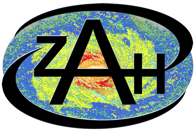My Research:
1. Star Formation and Young Star Clusters in the Milky Way and Magellanic
Clouds
Preamble
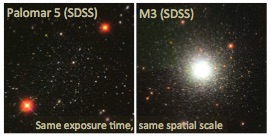 Star clusters cover a wide range of gravitationally bound stellar
agglomerates ranging from massive, compact, long-lived globular
clusters to low-mass, diffuse, short-lived associations, from
metal-poor objects to clusters with super-solar metallicity, and from
very old populations to embedded young clusters. It has been
suggested that all stars originally formed in clusters or asociations.
The study of the many types of clusters is worthwhile in its own right
and reveals important information on star formation processes and the
impact of galactic environment. A crucial advantage of star clusters
relative to field star populations is that they represent, to first
order, coeval populations and can be easily age-dated when they are
resolved into individual stars. Star clusters have been identified in
all galaxy types except for the least massive ones. As ensembles,
star clusters can serve as a very useful tracer of galaxian star
formation history.
Star clusters cover a wide range of gravitationally bound stellar
agglomerates ranging from massive, compact, long-lived globular
clusters to low-mass, diffuse, short-lived associations, from
metal-poor objects to clusters with super-solar metallicity, and from
very old populations to embedded young clusters. It has been
suggested that all stars originally formed in clusters or asociations.
The study of the many types of clusters is worthwhile in its own right
and reveals important information on star formation processes and the
impact of galactic environment. A crucial advantage of star clusters
relative to field star populations is that they represent, to first
order, coeval populations and can be easily age-dated when they are
resolved into individual stars. Star clusters have been identified in
all galaxy types except for the least massive ones. As ensembles,
star clusters can serve as a very useful tracer of galaxian star
formation history.
The work presented in this section was done with my past and present graduate students Andrea Dieball, Katharina Glatt, Andrea Kayser, Andreas Koch, Xiaoying Pang, Andrea Stolte, and Peter Zeidler.
Subtopics
- 1.1 The Stellar Initial Mass Function (IMF) and Mass Segregation
- 1.2 Effects of Massive Star Formation on Low-Mass and Sequential Star Formation
- 1.3 Emission-line Stars in Young Clusters
- 1.4 Age Spreads
- 1.5 Binary and Multiple Star Clusters
1.1 The Stellar Initial Mass Function (IMF) and Mass Segregation
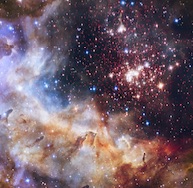 Both the slope(s) of IMF as a function of stellar mass and the
question of the universality of the IMF are topics of major importance
for many areas of astronomy, ranging from the details of star
formation to chemical enrichment and to the interpretation of
integrated stellar populations in distant galaxies. While there is
clear evidence for stochastic fluctuations at the high-mass end of the
IMF it is not clear whether there are also systematic variations as a
function of, e.g., environment.
Both the slope(s) of IMF as a function of stellar mass and the
question of the universality of the IMF are topics of major importance
for many areas of astronomy, ranging from the details of star
formation to chemical enrichment and to the interpretation of
integrated stellar populations in distant galaxies. While there is
clear evidence for stochastic fluctuations at the high-mass end of the
IMF it is not clear whether there are also systematic variations as a
function of, e.g., environment.
One way of addressing these questions is by directly determining the IMF in very young clusters; clusters young enough to not yet have been significantly affected by dynamical or stellar evolution. Our studies of young massive clusters with ground-based adaptive optics or with HST revealed such empirical measurements of the IMF to be more difficult than expected. My graduate students Andrea Stolte, Xiaoying Pang, and Peter Zeidler and I investigated several young massive clusters in detail (Arches (age 2 - 4 Myr), NGC 3603 (~ 1 Myr), and Westerlund 2 (~ 1 Myr)). They all turned out to show mass segregation despite their young age. We found radially varying mass functions and a concentration of high-mass stars in the cluster centers (e.g., Stolte et al. 2002, 2005; Pang et al. 2013). Interestingly, our results favor dynamical over primordial mass segregation, which may have implications for formation scenarios of very massive stars (Pang et al. 2013). In the Hubble Tarantula Treasury Project (HTTP; Sabbi et al. 2013), we are now extending these studies to the young clusters in 30 Doradus in the Large Magellanic Cloud (LMC).
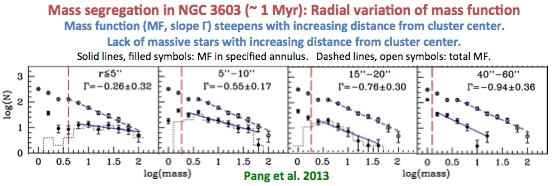
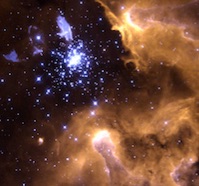 1.2 Effects of Massive Star Formation on Low-Mass
and Sequential Star Formation
1.2 Effects of Massive Star Formation on Low-Mass
and Sequential Star FormationMassive star formation in very dense environments may affect low-mass star formation in its vicinity and/or trigger subsequent star formation activity. In NGC 3603 we found the disk fraction for pre-main-sequence stars to increase from the center to the outskirts, indicating that photoevaporation caused by massive stars shortens the mass accretion time scale (e.g., Stolte et al. 2004). In Westerlund 2 we found the mass accretion rate of the pre-main-sequence stars to be 25% lower in close spatial proximity to main-sequence OB stars (Zeidler et al., in prep.). A young cluster's ionizing radiation also has a substantial impact on the surrounding nebula, clearing a cavity around the cluster and eroding the remaining pillars with higher gas and dust density as well as the envelopes of proplyds (e.g., Brandner et al. 2000; Pang, Pasquali, & Grebel 2011).
In very massive star-forming regions like 30 Doradus star clusters with a range of ages can be found (e.g., Grebel & Chu 2000). Here, we discovered the first pre-main-sequence stars detected in a galaxy other than the Milky Way and found evidence of sequential star formation presumably triggered by the central massive R136 cluster (Walborn et al. 1999; Brandner et al. 2001). The infrared HST data even revealed a very young, embedded, compact cluster in the vicinity of R136. We are now resuming these studies in the framework of the HTTP imaging survey with HST (e.g., Cignoni et al. 2015; Sabbi et al. 2015).

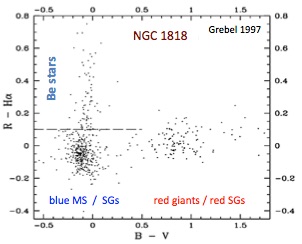 1.3 Emission-line Stars in Young Clusters
1.3 Emission-line Stars in Young Clusters
Young star clusters may contain various types of emission-line stars, for instance He I and He II emission-line stars such as O and B supergiants or He II-emitting WN stars, C III-emitting WC stars, or Balmer emission-line stars such as Be stars or pre-main-sequence stars. We developed a simple photometric method for the detection of such stars, which uses a narrow-band filter centered on the desired emission line in combination with broad-band filters to measure the continuum and colors of the stars (Grebel, Richtler, & de Boer 1992).
Applying this method to search for main-sequence Be stars in young clusters, we found that the Be star fraction among B main-sequence stars is highest among early-type B stars (Grebel et al. 1992, 1993; Grebel 1997; Grebel & Chu 2000; Keller et al. 2001). Furthermore, comparing clusters the Milky Way, the Large Magellanic Cloud, and the Small Magellanic Cloud, we found the Be star fractions to increase with lower metallicities (Grebel 1997; Maeder, Grebel, & Mermilliod 1999). We suggested that that the average rotation is faster at low metallicities, which in turn implies more rotational mixing and could explain the higher relative N enrichment found in massive metal-poor stars (Maeder et al. 1999).
Pre-main-sequence stars also show varying amounts of Hα emission depending on their mass accretion rate. In the young Galactic cluster Westerlund 2, we used our photometric technique to identify pre-main-sequence stars, to quantify their mass accretion rate, and to show that circumstellar disks around these low-mass stars get rapidly destroyed by the UV radiation emitted by massive OB stars (Zeidler et al., in prep.)
1.4 Age Spreads
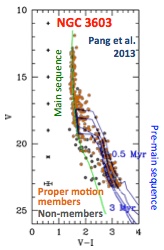 How coeval are the stars in a given star clusters? How long does star
formation proceed in a forming star cluster? We know that
extended stellar associations may show subgroups of different
ages, age gradients, and/or sequential star formation (e.g., Blaauw 1991). In compact, young, massive
star clusters the ages of the main-sequence and pre-main-sequence
stars hold important clues. However, it is difficult to accurately
age-date the upper main sequence photometrically and spectroscopically
due to uncertainties in the life times of massive OB stars and
additional effects introduced by rapid rotation and by the common
binarity of these stars (e.g., Grebel, Roberts, & Brandner 1996). The locus of
pre-main-sequence stars, on the other hand, is affected by the
continuing and variable accretion of circumstellar material and by the
individual inclination angles of the protostellar disks, which widen
the observed pre-main-sequence locus. Moreover, as already mentioned
in Section 1.2, once massive stars reach the main
sequence their radiation starts to evaporate the circumstellar disks
of lower-mass pre-main-sequence stars in their vicinity.
How coeval are the stars in a given star clusters? How long does star
formation proceed in a forming star cluster? We know that
extended stellar associations may show subgroups of different
ages, age gradients, and/or sequential star formation (e.g., Blaauw 1991). In compact, young, massive
star clusters the ages of the main-sequence and pre-main-sequence
stars hold important clues. However, it is difficult to accurately
age-date the upper main sequence photometrically and spectroscopically
due to uncertainties in the life times of massive OB stars and
additional effects introduced by rapid rotation and by the common
binarity of these stars (e.g., Grebel, Roberts, & Brandner 1996). The locus of
pre-main-sequence stars, on the other hand, is affected by the
continuing and variable accretion of circumstellar material and by the
individual inclination angles of the protostellar disks, which widen
the observed pre-main-sequence locus. Moreover, as already mentioned
in Section 1.2, once massive stars reach the main
sequence their radiation starts to evaporate the circumstellar disks
of lower-mass pre-main-sequence stars in their vicinity.
Nonetheless, the currently available data suggest that in young compact massive clusters age spreads, if any, seem to be small. For instance, a study of a careful proper-motion-based sample of member stars in the massive Galactic star cluster NGC 3603 by my graduate student Xiaoying Pang indicates an approximate mean age of 1 Myr for this object. The broad main-sequence turn-on region of the cluster supports an age spread of possibly up to two Myr, and the few older main-sequence member stars with lower luminosities than the bulk of the main sequence also suggest an earlier onset of star formation (Pang et al. 2013). However, it is also evident that star formation already progressed in that region prior to the formation of the massive cluster as evidenced by, e.g., the evolved supergiants found in its vicinity (e.g., Brandner et al. 1997a, 1997b). That young star clusters are embedded in environments with earlier as well as continuing star formation in their surroundings is also observed in many other extended massive star-forming regions, for instance in 30 Doradus (e.g., Grebel & Chu).
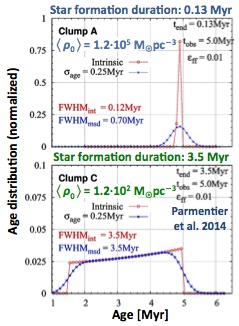 There
appears to be a trend that massive, high-density star clusters have
more narrow age distributions, which may be caused by star formation
progressing more rapidly in gas clumps with a higher density Parmentier, Pfalzner, & Grebel 2014). This yields
automatically smaller age spreads in the resulting higher-density
clusters. The time scale for star formation seems to be of the order
of one to four free-fall times (Parmentier et al. 2014).
There
appears to be a trend that massive, high-density star clusters have
more narrow age distributions, which may be caused by star formation
progressing more rapidly in gas clumps with a higher density Parmentier, Pfalzner, & Grebel 2014). This yields
automatically smaller age spreads in the resulting higher-density
clusters. The time scale for star formation seems to be of the order
of one to four free-fall times (Parmentier et al. 2014).
The discovery of multiple stellar populations in globular clusters (see Section 2.1) may indicate the presence of two or more stellar generations of different ages. This has reinvigorated the interest in possible age spreads in star clusters, particularly with respect to populations separated in age. If there are indeed multiple stellar generations, when and how did they form? Our Milky Way does not contain massive intermediate-age clusters in which one could catch such events as they are happening, but the Magellanic Clouds are rich in such clusters.
In a study to age-date intermediate-age clusters in the Small Magellanic Cloud (SMC) led my my graduate student Katharina Glatt, we detected the first cluster with possible multiple main-sequence turn-offs ever to be found in the SMC: NGC 419 (Glatt et al. 2008). Since then a growing number of such Magellanic clusters with ages typically between one to two Myr have been identified, but whether the extended turn-off regions seen in their color-magnitude diagrams are indeed caused by age spreads is a matter of debate. Other explanations, such as stellar rotation, have been proposed as well, which obviate the need for an age spread (e.g., Niederhofer et al. 2015 and references therin). Indeed, somewhat older massive intermediate-age clusters with ages of several Gyr appear to be entirely consistent with being single stellar populations (Glatt et al. 2008).
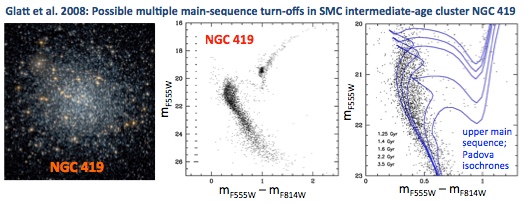
1.5 Binary and Multiple Star Clusters
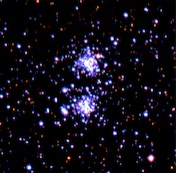 Individual young clusters may show substructure, for instance in
the form of two distinct density peaks (e.g., Zeidler et al. 2015), but one may also find other
clusters in their immediate neighborhood. This apparent proximity may
occur due to chance superpositions along our line of sight without
implying any physical connection, but the reverse may also be true
(for example, in the famous case of the double cluster h and χ
Persei in the Milky Way). But generally such constellations are rare
in the Milky Way. In the Magellanic Clouds, however, an unexpectedly
large number of apparent binary and multiple clusters was found.
Using the criteria laid out by Bhatia and collaborators, LMC clusters
with a separation less than 18 pc may be gravitationally bound to each
other (e.g., Bhatia & Hatzidimitriou 1988).
Individual young clusters may show substructure, for instance in
the form of two distinct density peaks (e.g., Zeidler et al. 2015), but one may also find other
clusters in their immediate neighborhood. This apparent proximity may
occur due to chance superpositions along our line of sight without
implying any physical connection, but the reverse may also be true
(for example, in the famous case of the double cluster h and χ
Persei in the Milky Way). But generally such constellations are rare
in the Milky Way. In the Magellanic Clouds, however, an unexpectedly
large number of apparent binary and multiple clusters was found.
Using the criteria laid out by Bhatia and collaborators, LMC clusters
with a separation less than 18 pc may be gravitationally bound to each
other (e.g., Bhatia & Hatzidimitriou 1988).
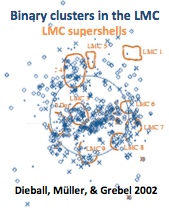 As part of
her PhD thesis work, Andrea Dieball identified possible binary
clusters in the LMC based on this proximity criterion and determined
the ages of the candidates via color-magnitude diagrams. A bit more
than 4000 clusters fulfilled Bhatia et al.'s proximity criterion. We
found that multiple cluster candidates are predominantly younger than
300 Myr. Many, though not all, are coeval within the age-dating
accuracy, which would support a physical connection and possibly
formation from the same giant molecular cloud. An alternative, though
probably less common possibilty for forming a cluster pair is via
tidal capture. Depending on the cluster density, between 56%
(high-density bar region) and 12% (outer LMC) of the detected pairs
would be expected statistically as chance superpositions, which leaves
a large number of possible physical pairs (Dieball & Grebel 1998, 2000; Dieball, Grebel, & Theis 2000; Dieball, Müller, & Grebel 2002). The
question of the long-term evolution of physical pairs remains open -
in principle, mergers are possible (which might have interesting
implications for multiple stellar populations in older clusters), or
both components may gradually dissolve.
As part of
her PhD thesis work, Andrea Dieball identified possible binary
clusters in the LMC based on this proximity criterion and determined
the ages of the candidates via color-magnitude diagrams. A bit more
than 4000 clusters fulfilled Bhatia et al.'s proximity criterion. We
found that multiple cluster candidates are predominantly younger than
300 Myr. Many, though not all, are coeval within the age-dating
accuracy, which would support a physical connection and possibly
formation from the same giant molecular cloud. An alternative, though
probably less common possibilty for forming a cluster pair is via
tidal capture. Depending on the cluster density, between 56%
(high-density bar region) and 12% (outer LMC) of the detected pairs
would be expected statistically as chance superpositions, which leaves
a large number of possible physical pairs (Dieball & Grebel 1998, 2000; Dieball, Grebel, & Theis 2000; Dieball, Müller, & Grebel 2002). The
question of the long-term evolution of physical pairs remains open -
in principle, mergers are possible (which might have interesting
implications for multiple stellar populations in older clusters), or
both components may gradually dissolve.
References
- Bhatia, R.K., & Hatzidimitriou, D. 1988, MNRAS, 230, 215
- Blaauw, A. 1991, in The Physics of Star Formation and Early Stellar Evolution, NATO Advanced Science Institutes (ASI) Series C, Vol. 342, eds. C.J. Lada & N.D. Kylafis (Dordrecht: Kluwer), p. 125
- Brandner, W., Grebel, E.K., Chu, Y.-H., & Weis, K. 1997a, ApJL, 475, L45
- Brandner, W., Chu, Y.-H., Eisenhauer, F., Grebel, E.K., & Points, S.D. 1997b, ApJL, 489, L153
- Brandner, W., Grebel, E.K., Chu, Y.-H., et al. 2000, AJ, 119, 292
- Brandner, W., Grebel, E.K., Barbá, R.H., Walborn, N.R., & Moneti, A. 2001, AJ, 122, 858
- Cignoni, M., Sabbi, E., van der Marel, R.P., Tosi, M., Zaritsky, D., Anderson, J., Lennon, D.J., Aloisi, A., de Marchi, G., Gouliermis, D.A., Grebel, E.K., Smith, L.J., & Zeidler, P. 2015, ApJ, 811, 76
- Dieball, A., & Grebel, E.K. 1998, A&A, 339, 773
- Dieball, A., & Grebel, E.K. 2000, A&A, 358, 897
- Dieball, A., Grebel, E.K., & Theis, C. 2000, A&A, 358, 144
- Dieball, A., Müller, H., & Grebel, E.K. 2002, A&A, 391, 547
- Glatt, K., Grebel, E.K., Sabbi, E., Gallagher, J.S., Nota, A., Sirianni, M., Clementini, G., Tosi, M., Harbeck, D., Koch, A., Kayser, A., & Da Costa, G. 2008, AJ, 136, 1703
- Grebel, E.K. 1997, A&A, 317, 448
- Grebel, E.K., & Chu, Y.-H. 2000, AJ, 119, 787
- Grebel, E.K., Richtler, T., & de Boer 1992, A&A, 254, L5
- Grebel, E.K., Roberts, W.J., Will, J.-M., & de Boer, K.S. 1993, SSRv, 66, 65
- Grebel, E.K., Roberts, W.J., & Brandner, W. 1996, A&A, 311, 470
- Keller, S.C., Grebel, E.K., Miller, G.J., & Yoss, K.M. 2001, AJ, 122, 248
- Maeder, A., Grebel, E.K., & Mermilliod, J.-C. 1999, A&A, 346, 459
- Niederhofer, F., Georgy, C., Bastian, N., & Ekström, S. 2015, MNRAS, 453, 2070
- Pang, X., Pasquali, A., & Grebel E.K. 2011, AJ, 142, 132
- Pang, X., Grebel, E.K., Allison, R.J., et al. 2013, ApJ, 764, 73
- Parmentier, G., Pfalzner, S., & Grebel, E.K. 2014, ApJ, 791, 132
- Sabbi, E., Anderson, J., Lennon, D.J., van der Marel, R.P., Aloisi, A., Boyer, M.L., Cignoni, M., De Marchi, G., de Mink, S.E., Evans, C.J., Gallagher, J.S., Gordon, K., Gouliermis, D.A., Grebel, E.K., et al. 2013, AJ, 146, 53
- Sabbi, E., Lennon, D.J., Anderson, J., Cignoni, M., van der Marel, R., Zaritsky, D., de Marchi, G., Panagia, N., Gouliermis, D., Grebel, E.K., et al. 2016, ApJS, 222, 11
- Stolte, A., Grebel, E.K., Brandner, W., & Figer, D.F. 2002, A&A, 394, 459
- Stolte, A., Brandner, W., Brandl, B., Zinnecker, H., & Grebel, E.K. 2004, AJ, 128, 765
- Stolte, A., Brandner, W., Grebel, E.K., Lenzen, R., & Lagrange, A.-M. 2005, ApJ, 628, L113
- Walborn, N.R., Barbá, R.H., Brandner, W., Rubio, M., Grebel, E.K., & Probst, R.G. 1999, AJ, 177, 225
- Zeidler, P., Sabbi, E., Nota, A., Grebel, E.K., Tosi, M., Bonanos, A.Z., Pasquali, A., Christian, C., de Mink, S.E., & Ubeda, L. 2015, AJ, 150, 78
Back to research overview
